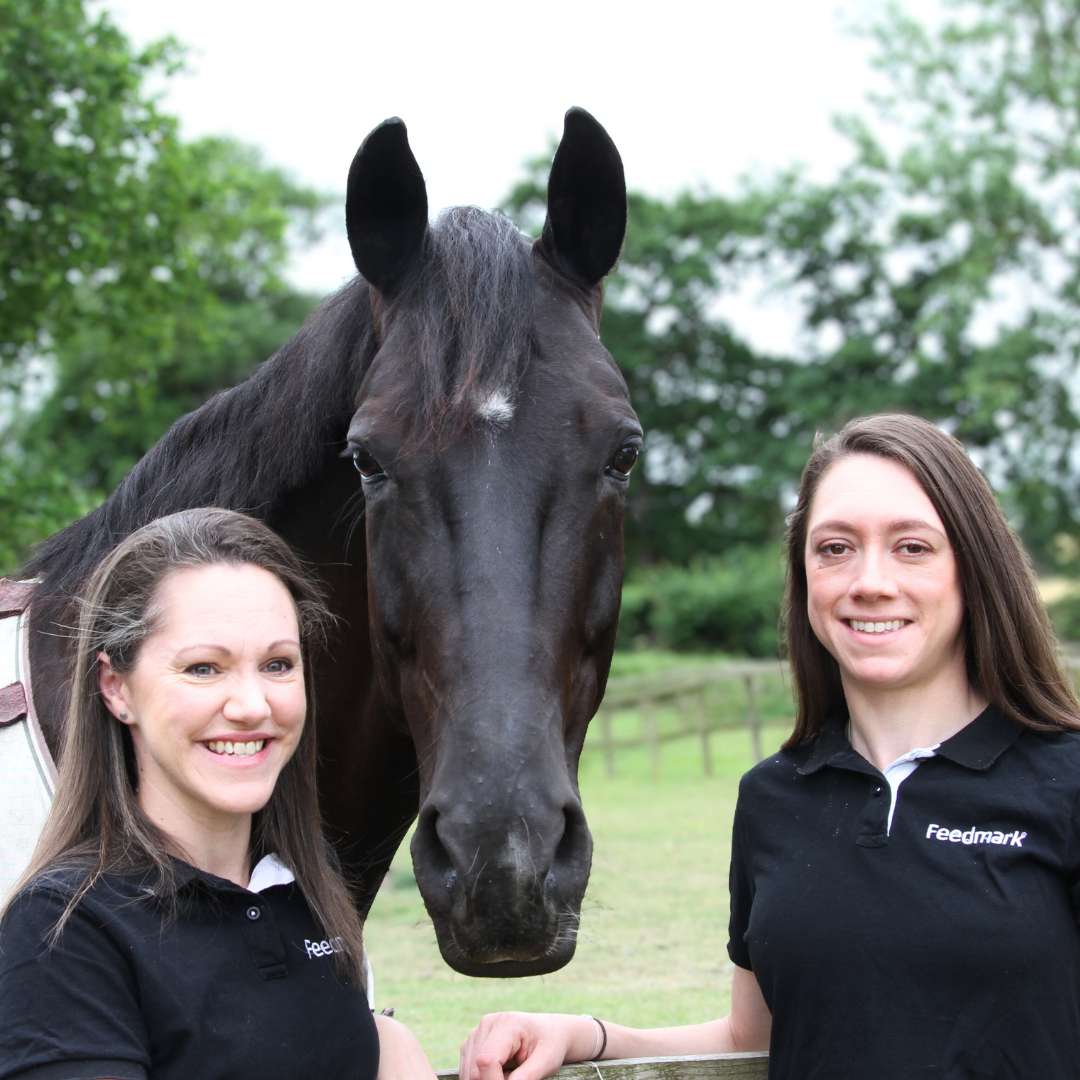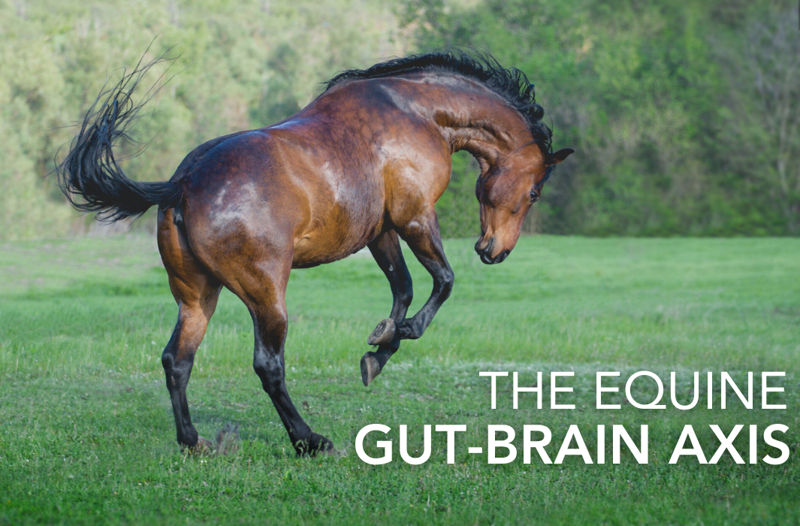Written by Sophie Pelham Burn (MMedSci ANutr.)
There is a great deal of literature and ongoing research into the gut-brain axis in humans, but did you know this super information highway between the digestive tract and brain is also of huge importance in horses too?
What is the Gut-Brain Axis in Horses?
The gut-brain axis is a bidirectional communication channel between the brain, the gut, and the gut microbiota. The vagus nerve that runs between the gastrointestinal tract and the brain, is a direct link connecting the horse’s gut and the central nervous system. It is responsible for carrying sensory signals from the gut to the brain, such as fullness and pain, and from the brain to the gut to slow digestion and redirect blood flow towards muscle during training and times of stress (ready for the fight or flight response). Therefore, this gut-brain connection in horses plays a crucial role in maintaining both digestive health and behaviour.
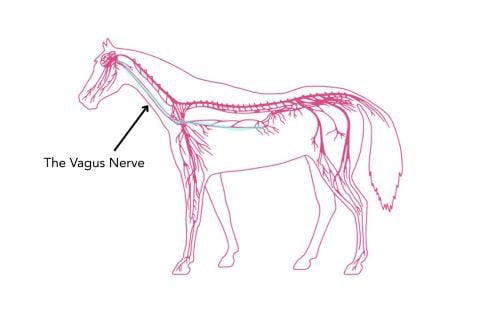
The horse nervous sysytem - highlighting the Vagus Nerve.
The Connection Between Gut Health and your Horse’s Immune System
The gut, or more specifically, the gut microbiota, also plays a key role in immune function. A large portion of the lymphatic system, referred to as gut-associated lymphatic tissue (GALT), is located alongside the hindgut and is home to approximately 70% of the immune system.
The close association of the immune system with the horse’s gastrointestinal tract allows an efficient response to any pathogens that have survived through the initial stages of digestion and the stomach acids but also acts as a ‘training ground’ to ensure proper regulation of the immune response.
As all the food that comes into the digestive tract is, technically, a foreign body entering the horse’s system, it would stand to reason that an immune response would be mounted against it. However, a very finely balanced tolerance exists between the immune response and non-harmful substances inside the gut. In effect, the GALT acts as a training ground for the immune system, helping to manage the immune response and inflammation around the gut, but also systemically. Research in humans suggests gut dysbiosis creates an unfavourable ‘training ground’ for the immune system as a plausible link between auto-immune or allergic responses and gut health, although evidence in horses is still lacking thus far.
How the Gut-Brain Axis Influences Horse Behaviour and Stress
The Role of Microbiota and Inflammation in Equine Behaviour:
In humans, this interaction of the microbiota and inflammatory response is also known to have an influence on mental health. Chronic inflammation leads to alterations in brain chemistry and has been noted to play a role in depression, fatigue, and anxiety.
In addition, the microbiota is responsible for producing a group of molecules called post-biotics. These are the by-products that are created when the good gut bugs digest pre-biotic fibres. Postbiotics include Short-Chain Fatty Acids (SCFA’s), amino acids, some vitamins, and neurotransmitters.
Serotonin and dopamine are two neurotransmitters that are produced in the gut and whose levels are directly influenced by the microbiota. They’re both responsible for regulating intestinal motility, i.e., digestion speed, but are most well known for their roles in mood regulation in the brain. Although the serotonin and dopamine produced in the gut can’t cross the blood-brain barrier to directly influence behaviour, the gut microbiome is responsible for circulating levels of the precursors of these two neurotransmitters, so changes to gut bacterial population can lead to a reduction in their synthesis and levels in the brain.
How High-Starch Diets Affect Your Horse’s Behaviour:
Further evidence of the connection between the gut microbiota and behaviour can be seen in horses fed a high starch diet. All cereals contain high-starch levels, and it’s well known that feeding a high cereal diet (with oats being the most notorious for it) can make horses fizzy or more anxious and ‘spooky’. This was originally thought to be due to the high energy content of the diet translating to higher energy levels in the horses’ behaviour; however, horses fed a low starch diet with equivalent energy levels do not exhibit these behavioural changes.
More contemporary thoughts on the topic are that the starch content of cereals aren’t digested and absorbed in the small intestine but continue through the digestive tract into the large intestine. Once in the large intestine, they alter the delicate balance of the microbiota, and it is this that affects the horses’ behaviour. Anecdotally, feeding a horse who is more ‘woah than go’ a high starch diet rarely leads to a more forward-going attitude to work, but does often increase reactivity and spookiness. This would seem to back up the theory that the behavioural effects are likely due to more complex changes than simply increased energy availability from the feed.
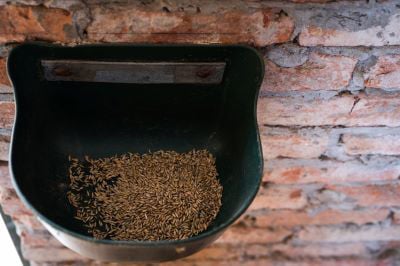
Oats are notorious for making horse's fizzy or more anxious and ‘spooky’.
Why Spring Grass Can Change Your Horse’s Mood:
A similar mechanism is likely at play with the arrival of spring grass, which can have starch and sugar levels as high as 40% dry weight. Levels are likely highest in the early morning, so if you notice a difference in your horses’ behaviour in the spring, turning out later in the day could help. The microbiota is very sensitive to change, with a difference in composition noted following something as seemingly insignificant as a new batch of hay.
This highlights the importance of making any changes or additions to feed gradually, including mixing old and new batches of hay to allow the microbiota to adjust, before a complete change to the new batch.
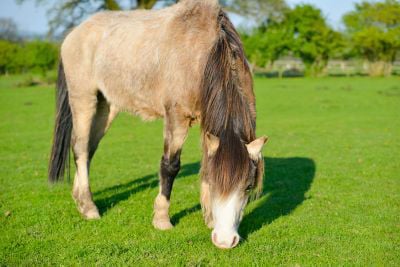
If you notice a difference in your horses’ behaviour due to spring grass, turning out later in the day could help.
Environmental Stress, Intestinal Permeability, and Behaviour:
Although gut dysbiosis can increase your horse’s behavioural stress, there is also evidence that stress from changes in environment, stable management routines, travel, or competition negatively impact the balance of the gut microbiota and increase intestinal permeability in horses. As the gut lining becomes more permeable, transport of various molecules across the intestinal wall becomes less tightly regulated, which can lead to low-grade chronic inflammation as unwanted substances make their way through. As previously mentioned, inflammation has been demonstrated to increase the likelihood of depression, anxiety, and fatigue in humans, and although the same has not yet been demonstrated in horses, the research in this area is evolving.
Therefore, stress levels directly impact the gut microbiota and vice versa. Horses with spooky or reactive behavioural issues, even without girthyness or other symptoms traditionally associated with gastrointestinal discomfort, may benefit from strategies targeted towards gut health.
Nutritional Strategies to Support Your Horse's Gut-Brain Axis
- Making gradual changes to feed and supplements.
- Altering turnout times gradually and avoiding early morning turnout as spring grass comes through.
- Ensure ad-lib access to forage.
- Consider reducing high-starch hard feeds and using alternative sources of energy.
- Consider introducing pre, pro, and postbiotics prior to stressful periods or changes in routine to support the stability of the microbiota.
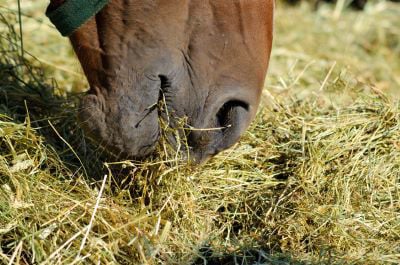
Mix old and new batches of hay to allow the microbiota to adjust, and awlays provide ad-lib forage.
Stable Management Strategies to Reduce Stress
- Keep to a consistent routine.
- Acclimate horses to travel before the beginning of a competition season or a long journey. Consider taking a stable mate if possible.
- Allow sufficient turnout time, ideally with herd mates.
- Consider stable toys to reduce boredom stress.
In conclusion, the equine gut-brain axis plays a crucial role in your horse’s immune function and behaviour. A balanced gut microbiota supports effective communication between the gut and brain via the vagus nerve, influencing stress, digestion, and mood. Nutritional strategies such as reducing high-starch feeds and adding prebiotics, probiotics, and postbiotics, alongside minimising environmental stress, helps to maintain gut health and reduces gut dysbiosis and intestinal permeability. As a horse owner, understanding the gut-brain connection is key to supporting your horse’s overall health and behaviour.
For any advice or questions you may have, please don't hesitate to reach out to our expert nutrition team. You can call 0800 585525 Monday-Friday 8:30am-5:00pm. Email [email protected], or send us a DM on social media.

